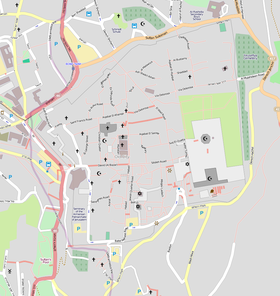Wilson's Arch (Jerusalem)

Western Wall, with view of Wilson's Arch (at left)
|
|
| Location | Jerusalem |
|---|---|
| Coordinates | 31°46′36″N 35°14′03″E / 31.776667°N 35.234167°E |
| Height | exposed: 20 feet (6 m) |
| History | |
| Builder | Disputed |
| Material | Limestone |
| Founded | Disputed |
| Site notes | |
| Condition | preserved |
Wilson's Arch is the modern name for the ancient stone arch whose top is still visible today, where it is supported against the Northeast corner of Jerusalem's Western Wall, so that it appears on the left to visitors facing the Wall. It once spanned 42 feet (13 m), supporting a road that continued for 75 feet (23 m) and allowed access to a gate that was level with the surface of the Temple Mount during the time of Jesus.
The arch was identified in 1864 by 19th-century explorer and surveyor Charles William Wilson, for whom it is now named. Wilson had joined the Ordnance Survey of Jerusalem in 1864, continuing to participate in the city surveying project that was established to improve the city's water system. The Palestine Exploration Fund (PEF) later commissioned him to survey Western Palestine, as well.
While the arch is named for Wilson, there is a claim that Swiss physician Titus Tobler had earlier discovered and identified the structure as part of the bridge between the Temple Mount and the Upper City in his 1845/46 writings. According to some, Tobler passed on information about the arch to Wilson, whose name was linked to the arch because he was the one who publicized the find.
The Arch was "rediscovered" in 1963 by Duke University archeologist Dr. D. F. Stinespring, Professor of Old Testament and Semitics at the Duke Divinity School, who continued his exploration of the "hidden tunnels" associated with the ancient Temple during the university's summer breaks.
The date of its original construction is disputed, as some scholars date it to before the destruction of Herod's temple in AD 70, while others place it much later, to the Arab Umayyad Period, 651–750. Stinesbring believed that the Arch had not been rebuilt, believing that the way it was bonded to the wall around the Temple indicated it was part of the plan during Herod's time: "a definitive part of the ancient Temple structure." Today, scholars do agree that the site of this current arch was the beginning of a series of arches that spanned the central valley, connecting the Temple Mount to Jerusalem's western hills. It is believed by those who date the arch to the later period that it was a replacement for an earlier arch erected during the Second Temple period.
...
Wikipedia

